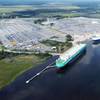The U.S. Environmental Protection Agency (EPA) has given the Port of Los Angeles a $250,000 grant to help monitor air quality around the City’s shipping port in San Pedro, the nation’s busiest container port.
The money will be used for the Port’s ambient air quality monitoring program, currently in operation at the Port. The project, which was initiated by the port in October 2005, primarily measures diesel particulate matter, is expected to last 18 months and will cost $1.25m.
The grant will enhance the Port of Los Angeles’ capability to monitor air toxics, especially polycyclic aromatic hydrocarbons, a product of incomplete combustion.
Polycyclic aromatic hydrocarbons or PAH’s are a group of over 100 different chemicals that are formed during the incomplete burning of coal, oil and gas, garbage, or other organic substances like tobacco or charbroiled meat. PAHs are usually found as a mixture containing two or more of these compounds, such as soot.
PAH’s are a carcinogen and can exacerbate upper respiratory illnesses. Measurement of PAH’s will help provide continuous data about the amount of diesel particulate matter in the air. By combining PAH measurements with available meteorological data and information from the port’s existing air quality monitoring program, the port will be able to characterize emission sources and potential ambient air quality impacts from its operations.
With 3,000 ship calls a year and $100 million in goods moving through the port annually, the Port of Los Angeles is a major economic center for the nation and one of the nation’s most important ports. It is in the middle of an air quality monitoring program that will measure ambient levels of diesel particulate matter in the vicinity of the port and adjacent communities, measure the effect of efforts to cut diesel emissions and validate health risk assessments.
In addition, the Port of Los Angeles, in partnership with neighboring Port of Long Beach and with the assistance of the U.S. EPA and other environmental agencies, recently announced a Clean Air Action Plan that provides a blueprint for significantly reducing the air emissions from all sources of Port operations within the next five years.
Subscribe for
Maritime Reporter E-News
Maritime Reporter E-News is the maritime industry's largest circulation and most authoritative ENews Service, delivered to your Email five times per week










